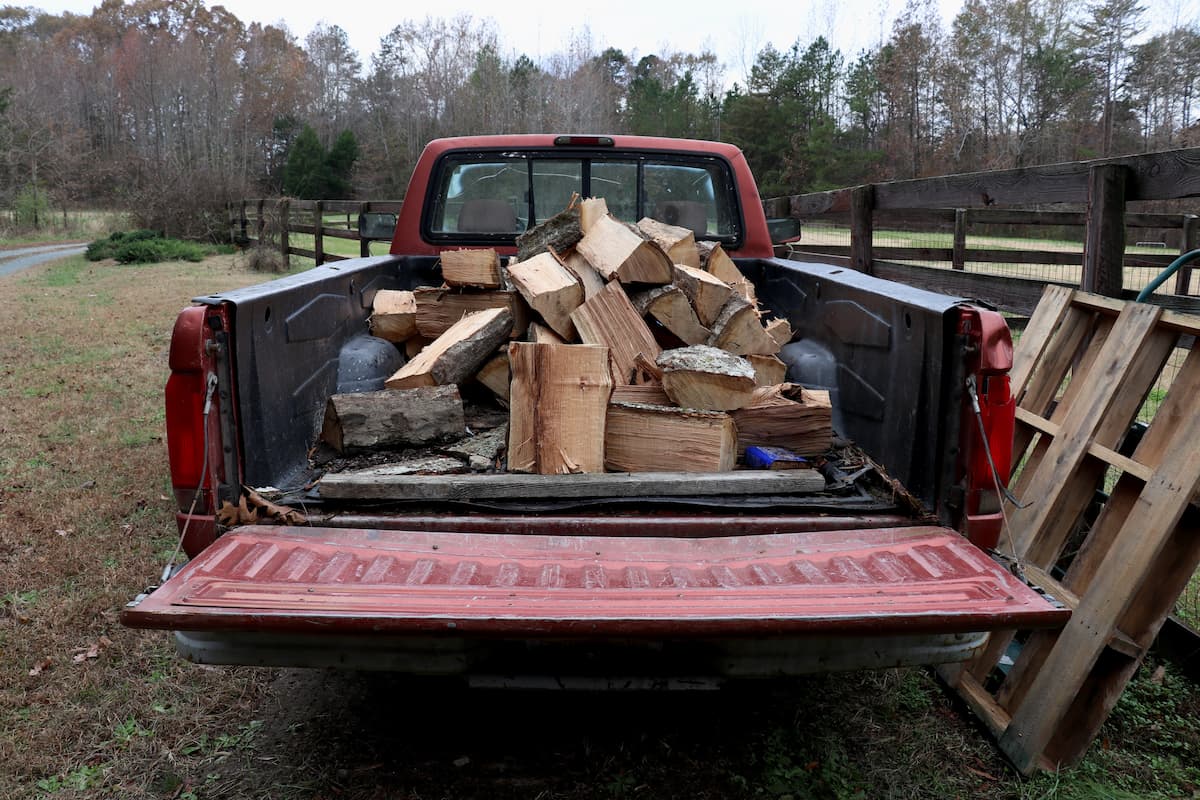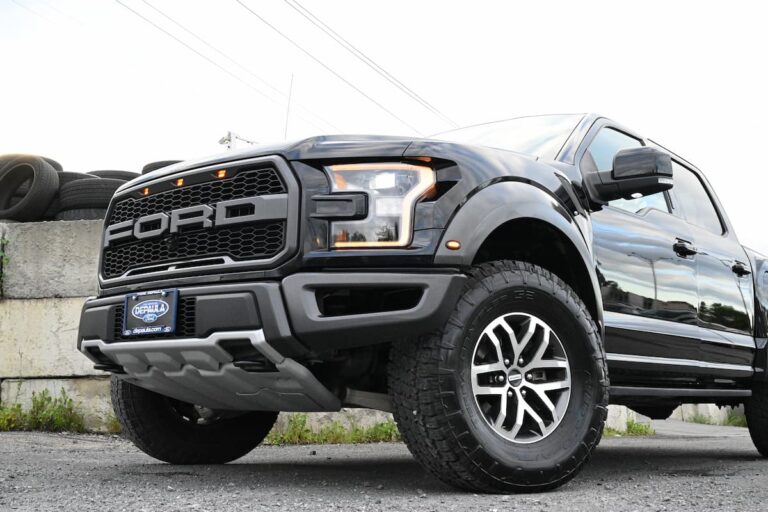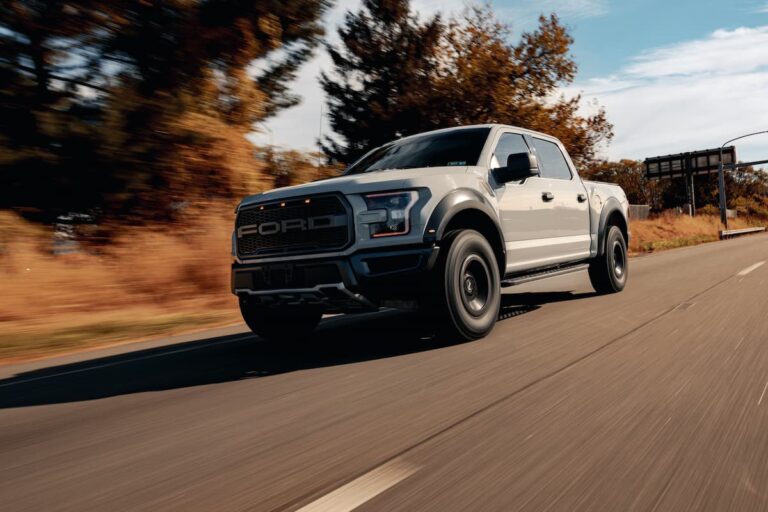How Much Weight Can Ford F-150 Hold In Bed?
Understanding your payload capacity is vital if you want to haul anything in the bed of your F-150.
Along with knowing your truck’s towing capacity, figuring out the maximum weight your F-150 can hold can save you from expensive repairs down the line.
The total weight a Ford F-150 can hold in its bed ranges from 1,410 lbs to 3,250 lbs (640 kg to 1474 kg). Your truck’s max capacity depends on various factors, including the engine, bed size, and drivetrain. When calculating your vehicle’s rating, don’t forget to account for passenger weight in addition to cargo weight.
Your truck’s payload rating can be found in your owner’s manual. Ford changes the ratings almost every year, so refer to the numbers specific to your F-150.
F-150 Payloads Per Configuration

Four factors determine your truck’s payload capacity: cab style, engine output, bed size, and drivetrain.
The F-150 offers three cab styles:
- Regular
- SuperCab
- SuperCrew.
Six powertrains:
- 3.3-liter V-6
- 2.7-liter EcoBoost V-6
- 5.0-liter V-8
- 3.0-liter Power Stroke V-6, turbo-diesel
- 3.5-liter EcoBoost V-6
- 3.5-liter PowerBoost V-6, hybrid.
Three bed lengths:
- 5.5 ft (1.68 m)
- 6.5 ft (1.98 m)
- 8 ft (2.44 m).
And two drivetrains: 4×2 and 4×4.
Different combinations of these metrics produce different payload capacities, as seen below.
Regular Cab
- 3.3L Ti-VCT V6, 6.5-foot (1.98 m) bed, 4×2: 1,985 lbs (900 kg)
- 3.3L Ti-VCT V6, 6.5-foot (1.98 m) bed, 4×4: 1,775 lbs (805 kg)
- 3.3L Ti-VCT V6, 8-foot (2.44 m) bed, 4×2: 1,975 lbs (896 kg)
- 3.3L Ti-VCT V6, 8-foot (2.44 m) bed, 4×4: 1,960 lbs (889 kg)
- 2.7L EcoBoost V6, 6.5-foot (1.98 m) bed, 4×2: 1,875 lbs (850 kg)
- 2.7L EcoBoost V6, 6.5-foot (1.98 m) bed, 4×4: 1,705 lbs (773 kg)
- 2.7L EcoBoost V6, 8-foot (2.44 m) bed, 4×2: 1,905 lbs (864 kg) (up to 2,480 lbs/1,125 kg with V6 payload package)
- 2.7L EcoBoost V6, 8-foot (2.44 m) bed 4×4: 1,885 lbs (855 kg) (up to 2,125 lbs/964 kg with V6 payload package)
- 5.0L Ti-VCT V8, 6.5-foot (1.98 m) bed, 4×2: 1,900 lbs (862 kg)
- 5.0L Ti-VCT V8, 6.5-foot (1.98 m) bed, 4×4: 1,835 lbs (832 kg)
- 5.0L Ti-VCT V8, 8-foot (2.44 m) bed, 4×2: 2,350 lbs (1,066 kg) (up to 3,325 lbs/1,508 kg with heavy-duty payload package)
- 5.0L Ti-VCT V8, 8-foot (2.44 m) bed, 4×4: 2,300 lbs (1,043 kg) (up to 3,050 lbs/1,383 kg with heavy-duty payload package)
- 3.5L EcoBoost V6, 8-foot (2.44 m) bed, 4×2: 2,620 lbs (1,188 kg) (up to 3,250 lbs/1,474 kg with heavy-duty payload package)
- 3.5L EcoBoost V6, 8-foot (2.44 m) bed, 4×4: 2,360 lbs (1,070 kg) (up to 3,035 lbs/1,376 kg 2 with heavy-duty payload package)
SuperCab
- 3.3L Ti-VCT V6, 6.5-foot (1.98 m) bed, 4×2: 1,905 lbs (864 kg)
- 3.3L Ti-VCT V6, 6.5-foot (1.98 m) bed, 4×4: 1,880 lbs (853 kg)
- 2.7L EcoBoost V6, 6.5-foot (1.98 m) bed, 4×2: 1,885 lbs (855 kg) (up to 2,175 lbs/987 kg with V6 payload package)
- 2.7L EcoBoost V6, 6.5-foot (1.98 m) bed, 4×4: 1,745 lbs (792 kg) (up to 2,165 lbs/982 kg with V6 payload package)
- 2.7L EcoBoost V6, 8-foot (2.44 m) bed, 4×2: 1,925 lbs (873 kg) (up to 2,225 lbs/1,009 kg with V6 payload package)
- 5.0L Ti-VCT V8, 6.5-foot (1.98 m) bed, 4×2: 2,345 lbs (1,064 kg)
- 5.0L Ti-VCT V8, 6.5-foot (1.98 m) bed, 4×4: 2,240 lbs (1016 kg)
- 5.0L Ti-VCT V8, 8-foot (2.44 m) bed, 4×2: 2,325 lbs (1054 kg) (up to 3,010 lbs/1,365 kg with heavy-duty payload package)
- 5.0L Ti-VCT V8, 8-foot (2.44 m) bed, 4×4: 2,205 lbs (1,000 kg) (up to 2,765 lbs/1,254 kg with heavy-duty payload package)
- 3.0L Power Stroke V6, 6.5-foot (1.98 m) bed, 4×4: 1,840 lbs (835 kg)
- 3.5L EcoBoost V6, 6.5-foot (1.98 m) bed, 4×2: 2,290 lbs (1,039 kg)
- 3.5L EcoBoost V6, 6.5-foot (1.98 m) bed, 4×4: 2,190 lbs (993 kg)
- 3.5L EcoBoost V6, 8-foot (2.44 m) bed, 4×2: 2,285 lbs (1,036 kg) (up to 2,980 lbs/1,352 kg with heavy-duty payload package)
- 3.5L EcoBoost V6, 8-foot (2.44 m) bed, 4×4: 2,125 lbs (964 kg) (up to 2,740 lbs/1,243 kg with heavy-duty payload package)
Super Crew
- 3.3L Ti-VCT V6, 5.5-foot (1.68 m) bed, 4×2: 1,785 lbs (810 kg)
- 3.3L Ti-VCT V6, 5.5-foot (1.68 m) bed, 4×4: 1,765 lbs (800 kg)
- 2.7L EcoBoost V6, 5.5-foot (1.68 m) bed, 4×2: 1,815 lbs (823 kg) (up to 1,960 lbs/889 kg with V6 payload package)
- 2.7L EcoBoost V6, 5.5-foot (1.68 m) bed, 4×4: 1,760 lbs (798 kg) (up to 1,965 lbs/891 kg with V6 payload package)
- 2.7L EcoBoost V6, 6.5-foot (1.98 m) bed, 4×2: 1,830 lbs (830 kg) (up to 2,085 lbs/946 kg with V6 payload package)
- 5.0L Ti-VCT V8, 5.5-foot (1.68 m) bed, 4×2: 2,135 lbs (968 kg) (up to 2,335 lbs/1,059 kg with heavy-duty payload package)
- 5.0L Ti-VCT V8, 5.5-foot (1.68 m) bed, 4×4: 2,135 lbs (968 kg)
- 5.0L Ti-VCT V8, 6.5-foot (1.98 m) bed, 4×2: 2,235 lbs (1,014 kg) (up to 2,900 lbs/1,315 kg with heavy-duty payload package)
- 5.0L Ti-VCT V8, 6.5-foot (1.98 m) bed, 4×4: 2,135 lbs (968 kg) (up to 2,650 lbs/1,202 kg with heavy-duty payload package)
- 3.0L Power Stroke V6, 5.5-foot (1.68 m) bed, 4×4: 1,805 lbs (819 kg)
- 3.0L Power Stroke V6, 6.5-foot (1.98 m) bed, 4×4: 1,805 lbs (819 kg)
- 3.5L EcoBoost V6, 5.5-foot (1.68 m) bed, 4×2: 2,050 lbs (930 kg) (up to 2300 lbs/1,043 kg with maximum trailer package)
- 3.5L EcoBoost V6, 5.5-foot (1.68 m) bed, 4×4: 2,100 lbs (953 kg)
- 3.5L EcoBoost V6, 6.5-foot (1.98 m) bed, 4×2: 2,245 lbs (1,018 kg) (up to 2,880 lbs/1,306 kg with heavy-duty payload package)
- 3.5L EcoBoost V6, 6.5-foot (1.98 m) bed, 4×4: 2,155 lbs (959 kg) (up to 2,640 lbs/1,197 kg with heavy-duty payload package)
- 3.5L PowerBoost Full Hybrid V6, 5.5-foot (1.68 m) bed, 4×2: 2,090 lbs (948 kg)
- 3.5L PowerBoost Full Hybrid V6, 5.5-foot (1.68 m) bed, 4×4: 1,830 lbs (830 kg)
- 3.5L PowerBoost Full Hybrid V6, 6.5-foot (1.98 m) bed, 4×2: 2,120 lbs (962 kg)
- 3.5L PowerBoost Full Hybrid V6, 6.5-foot (1.98 m) bed, 4×4: 1,810 lbs (821 kg)
- High-Output 3.5L EcoBoost V6, 5.5-foot (1.68 m) bed, 4×4: 1,410 lbs (640 kg)
How To Calculate Payload Capacity
To calculate your truck’s payload capacity, you need two ratings: the Gross Vehicle Weight Rating (GVWR) and the curb weight.
The GVWR is the maximum weight of the F-150 when accounting for cargo, passengers, body, alterations, and tongue weight.
The curb weight is your truck’s weight rating with a full fuel tank and no cargo, passengers, or modifications.
For example, the 2021 Ford F-150 Lariat has a GVWR of 6,600 lbs (2,993 kg) and a curb weight of 4,838 lbs (2,194 kg).
Getting your vehicle’s payload capacity is as simple as subtracting the curb weight from the GVWR (i.e., the loaded truck minus the empty truck).
The formula is GVWR – curb weight = payload capacity.
So, using our previous example, the payload capacity for the 2021 F-150 Lariat is:
6,600 lbs – 4,838 lbs = 1,762 lbs (799 kg).
(Ford rounds down, so officially, the payload rating is 1760 lbs/798 kg.)
You can find your truck’s GVWR and curb weight in your owner’s manual.
How Many Cubic Feet Can the Ford F-150 Hold In Its Bed?

The F-150 cargo volume depends on its bed dimensions.
An 8-foot (2.44 m) bed has a cargo volume of 77.4 cubic feet (2.19 cubic meters).
A 6.5-foot (1.98 m) bed has a cargo volume of 62.3 cubic feet (1.76 cubic meters).
A 5.5-foot (1.68 m) bed has a cargo volume of 52.8 cubic feet (1.5 cubic meters).
Conclusion
Understanding your F-150’s payload capacity is crucial for hauling and towing. Excess weight strains the truck, which reduces handling and can lead to an accident.
If you aren’t familiar with your truck’s capacity, either check your owner’s manual or calculate it using the truck’s GVWR and curb weight.




